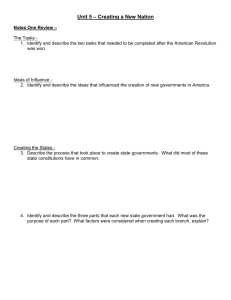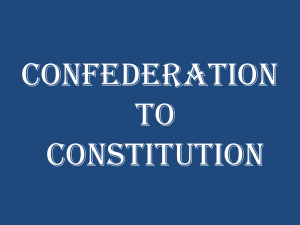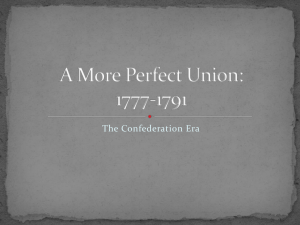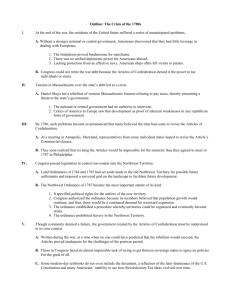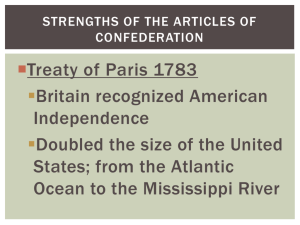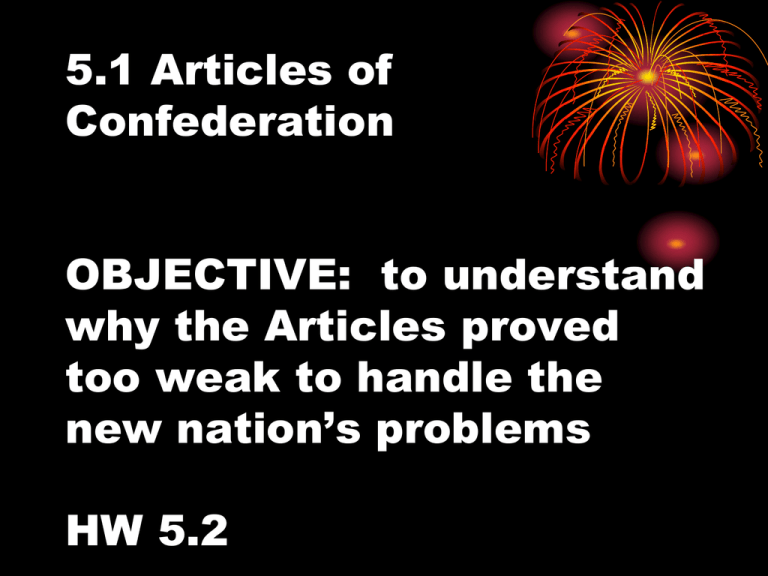
5.1 Articles of
Confederation
OBJECTIVE: to understand
why the Articles proved
too weak to handle the
new nation’s problems
HW 5.2
Revolution or Evolution?
Egalitarian movements:
Quakers found antislavery society in 1775
Anglican church is disestablished
Primogeniture laws repealed
Property-holding voting requirements reduced or abolished
Trade organizations spreading
Expansion of women’s roles – “republican motherhood”
NOTE: Departure of many prominent Loyalists and Tories means that
there are few “conservative” elements
http://www.gilderlehrma
n.org/teachers/module_p
op_resource.php?modul
e_id=82&resource_id=15
46
REPUBLICANISM
Americans after the revolution believed:
• Power arises from the consent of the
governed = the people
• DID NOT WANT a direct democracy.
(WHY?)
THEREFORE, a Republic was the best
form of government.
PROS?
CONS?
Can you think of an example of a
direct democracy?
How would the Presidency of the
US be different today if we were a
direct democracy?
How would making Loyola a direct
democracy change our student
government?
HOW TO RULE?
• Republic, YES.
• Supreme power? NO!!!
• SOLUTION a confederation
How is a confederation different
from a federal government (
what we have today)?
Confederation to
Constitution
•
•
•
•
1775, Colonies form state constitutions
1780, Massachusetts holds first constitutional convention
1781, Articles of Confederation approved
Economic Democracy spreading as Loyalist estates
divided, pensions to rev. soldiers,
• Land Ordinance of 1785 Western Lands opened w/o
slavery
• Northwest Ordinance of 1787 ensures that land rich and
land poor states share equally in debts and riches of
independence
CONFEDERATION VS.
FEDERALISM
FEDERAL GOVERNMENT
13 COLONIES
THE WESTERN LANDS
PROBLEM
• The most powerful states (VA, NY, MA) claim
lands in Ohio and beyond old line of
demarcation
• MD refuses to sign Articles. WHY?
• SOLUTION:
Lands become property of the UNITED states
LAWS:
Land Ordinance of 1785
= rules for surveying the new lands
Northwest Ordinance of 1787
= rules for dividing the land into states and
admitting them to the union.
Map: The United States in 1787
The United States in 1787
This map shows the extent of American westward settlement in 1787 and the limits placed on that settlement by French and
Spanish claims west of the Mississippi and in Florida. Plans for the creation of three to five states in the Northwest territory
were approved by Congress in 1787, ensuring that the settlers in this region would enjoy the same political rights as the
citizens of the original thirteen states.
Copyright © Houghton Mifflin Company. All rights reserved.
Map: Western Land Claims and Cessions, 1782-1802
Western Land Claims and Cessions, 1782-1802
After the United States achieved independence, states competed with each other for control of valuable lands to which they
had possible claims under their original charters. That competition led to a series of compromises among the states or
between individual states and the new nation, which are indicated on this map.
Copyright © Houghton Mifflin Company. All rights reserved.
Map: The Northwest Territory, 1785-1787
The Northwest Territory, 1785-1787
The Ordinance of 1785 provided for surveying land into townships of thirty-six sections, each supporting four families on
160-acre plots (approximately twenty-five people per square mile). In 1787 the Northwest Ordinance stipulated that states
Copyright © Houghton Mifflin Company. All rights reserved.
would ultimately be created in the region.
Articles of
Confederation
The Limits of Limited Government:
1. No common currency or banking laws
2. Unable to settle disputes over
commerce between states
3. Unable to have stable govt. funding or
to collect taxes
4. Unanimity necessary to amend (Rhode
Island creates problems!!!)
5. Unable to deal with foreign powers, i.e.
N. African Pirates
6. Weak army and navy
7. Unable to respond to Shay’s rebellion
Look on page 129.
What were the two biggest
problems facing the new
government?
In light of this, what were the
greatest weaknesses of the
Articles of Confederation?
Free ain’t Easy
Problems in the Confederation
•
Political and Economic
1.
•
•
2.
3.
4.
States are unbalanced politically in regards to
population
War debt
Continental Currency is worthless
No trade regulations, taxes, or tariffs
1.
2.
3.
Bankruptcies increasing
High taxes
Cheap currency lowers debt, hurts banks
1.
2.
3.
4.
Spain menaces borders
France demands repayment
Navigation Acts still a problem
N. African Piracy a growing problem
Borrowers vs. Lenders
Foreign Relations


